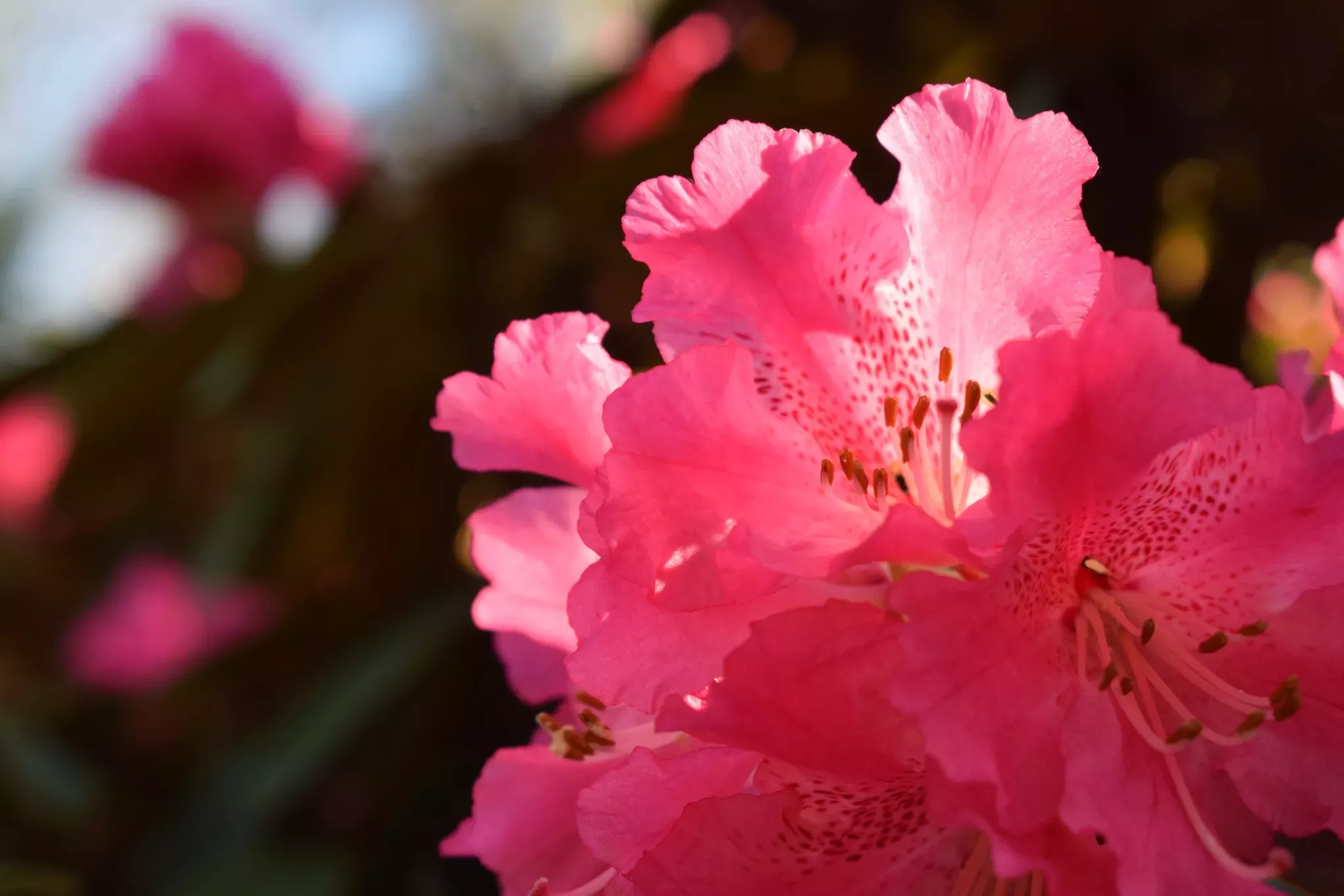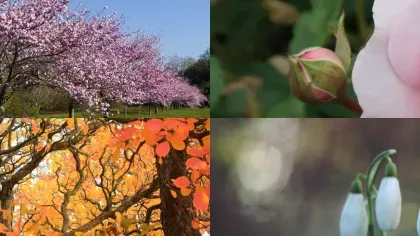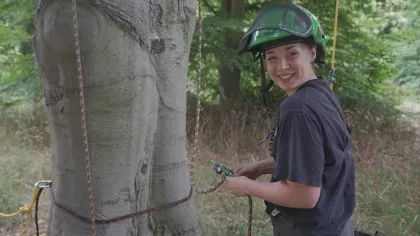30 August 2022
Visit the spots at Kew as seen on TV
Discover the botanical delights in our gardens as seen on series two of Kew Gardens: A Year in Bloom.

The fascinating six-part documentary series Kew Gardens: A Year in Bloom showcases the beautiful landscapes, extraordinary plants and dedicated staff in our gardens at Kew and Wakehurst.
Each of the hour-long episodes takes you behind the scenes of our world-leading horticulture and science, spanning the four seasons from spring to winter.
Now’s your chance to follow in the footsteps of the Channel 5 documentary and visit the spots as seen on TV.
Our glasshouses
On your visit to Kew Gardens, you won’t want to miss taking in the botanical and architectural splendour of our glasshouses.
Step inside the Princess of Wales Conservatory, the home of our annual winter orchid festival, as seen in the sixth episode of the series.
When this spectacular glasshouse isn’t hosting Orchids, you can explore the 10 different climatic zones and see a huge variety of plants, from cacti to carnivorous plants to bromeliads.
Also home to the smelliest plant on Earth titan arum (Amorphophallus titanum), its famous bloom is often on display between spring and autumn. Stinking of rotting flesh, keep your nostrils flared on your next visit — it won't be hard to miss!
Adding to the treasure trove, The Princess of Wales Conservatory is the only place in the world where you can see three species of giant waterlilies side by side, including one of Kew's latest botanical discoveries Victoria boliviana — the largest waterlily in the world.
You'll also find breaking botanical discovery, Victoria boliviana, in our Waterlily House, built originally to house the natural wonder of the Victorian age, the giant Victoria amazonica.
And don't miss our rare blue amaryllis in the Temperate House that recently flowered for the first time after 10 years in our collections, as seen on TV.


The Arboretum
Our Arboretum at Kew looks stunning throughout the year and changes with the seasons.
The trees display a stark beauty in winter, unfurling leaves and blossom in spring, lush green foliage in summer and a spectrum of fiery shades in autumn.
If you’ve seen the documentary, you’ll be familiar with the Tree Gang and their adventures. This group of expert arboriculturists care for, protect and maintain our trees.
Kew’s chief tree guardian, and head of the Arboretum, Kevin Martin is seen using sophisticated technology to investigate what is happening inside some sickly trees, suffering from fatal storm damage and an aggressive fungus.
Delve behind the scenes in epsiode two to see Kew horticulturalists Fran Culverhouse and Jenny Crabb in our state-of-the-art Arboretum Nursery using old skills and new tech to find the perfect seedlings to restore our UNESCO world heritage vista.
On your next visit, wander around the Gardens and see if you can spot any of the trees the gang climbed up, such as the majestic Red Oak near the Pagoda Vista.


Just off the Arboretum, you'll spot our ten-storey tall Great Pagoda; a place of great history, from a playground for Princess Augusta in the 1700s, being used for testing bombs in WW2, through to the cutting-edge restoration that has returned dragons to its rooftop.
Watch episode one to receive a guided tour with Rachel Mackay from Historic Royal Palaces, the charity that cares for this unique building.

Rhododendron
Showcasing our stunning collection of rhododendon, Kew's hidden Rhododendron Dell looks best in April and May.
Sir Joseph Hooker brought back many new specimens of rhododendron from his travels to the Himalayas in the mid-19th century.
Today, dense clusters of rhododendrons flower in the dell, including unique hybrids that can't be found anywhere else in the world.
As well as at Kew, we also have magnificent displays of rhododendrons at Wakehurst. Top spots include Himalayan Glade and Westwood Valley.
Both of our rhododendron collections have global conservation significance. Combined, we have the second most important rhododendron conservation collection in a botanic garden in the world.
Did you know? The rhododendron is actually a small tree and can live up to 100 years.

But not all rhododendron are welcome in our gardens.
Watch Katie Thorpe and the tree gang remove invasive rhododendron threatening Wakehurst's plant collection in episode three of Kew Gardens: A Year In Bloom.
You'll see it's risky business, involving abseiling with chainsaws to get to those hard-to-reach places.

Wakehurst
Our wild botanic garden in Sussex, Wakehurst, is where science and horticulture come together in a wild and undulating landscape.
A highlight of this series is the return of Wakehurst aficionado and Conservation Supervisor Steven Robinson.
With over 30 years at Wakehurst under his belt, Steven is helping to manage Wakehurst's woodland and meadows through coppicing trees, caring for resident grazers like our Hebridean sheep and Riggit Galloway cattle, and keeping ancient traditions alive by making charcoal.
And who can forget the adorable dormice?
During this channel 5 series, you will have virtually visited the American Prairie, a six-acre designed conservation landscape that is evolving week by week.
You will have also seen our incredible Millennium Seed Bank which stores 2.4 billion seeds from across the world as an insurance policy for the future and even get to meet a plant grown from a 200-year-old seed that was found in a wallet!
To keep the seeds safe and secure, the bank has a vault door and 24-7 security. The underground vaults are also flood, bomb and radiation-proof.
See our scientists at work from the Millennium Seed Bank’s glass atrium.

Edible Science: Kew's Kitchen Garden
Want to visit the newly-renovated Edible Science: Kew's Kitchen Garden where Botanical Horticulturist Hélèna Dove grows tasty produce?
From plump tomatoes to giant pumpkins, lots of fruit and vegetables are grown here.
The garden is involved in many Kew Science studies, such as the Crop Wild Relatives project which looks at the wild cousins of our favourite crops for genetic traits that could protect our food from threats such as drought, disease and climate change.
One example is oca, an alternative to the potato.
Some of the produce ends up on the menu in our restaurants, so visit our Pavilion Bar and Grill to sample the delights.
As seen in the series, Hélèna recently adopted the rather unusual job of adding plants to some giant sized, mythical wooden trolls that have come to the Gardens for an exhibition at Food Forever.


Behind the scenes
The show sometimes goes behind the scenes to places not accessible to the public, like the Tropical Nursery and Arboretum Nursery.
But we can take you there virtually.
Escape to Kew Gardens and Wakehurst from your sofa with Virtual Kew where you can find virtual tours, sneak peeks and many more behind-the-scenes gems.



